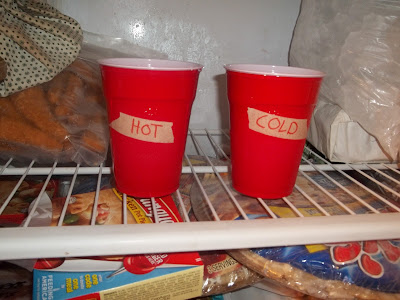Questions/Activities:
1. Post a picture of three
3-dimensional Ball and Stick molecular models(choose your three favorite
molecules) that you have created with common items around your home. Also post
a molecular structure image(image from the web, of either a Kekule Structure or
a Ball and Stick Model) and the IUPAC name of the molecule.
Key to Colors
Pink is Carbon
Yellow is Hydrogen
Green is Oxygen
 |
| Propane C3H8 |
 |
| Propane Molecular Structure |
 |
| Ethonal or Ethyl Alcohol C2H60 |
 |
| Molecular Structure of Ethonal |
 |
| Carbon Dioxide CO2 |
 |
| Molecular Structure of Carbon Dioxide |
2. Post an image from the web,
the chemical systematic (IUPAC) name, common name, and the molecule formula for
20 chemicals that you use or eat. Explore the ingredients of things like
cosmetics and foods.
 |
| After Shave (IUPAC Name: Potassium Alum) KAl(SO4)2 |
 |
| Aluminum Foil (IUPAC Name: Aluminum) Al |
 |
| Baking Soda (IUPAC Name: Sodium Bicarbonate) NaHCO3 |
 |
| Bleach (IUPAC Name: Sodium Hypochlorite) NaOCl |
 |
| Borax (IUPAC Name: Sodium Borate) Na2[B4O5(OH)4]x8H20 |
 |
| Bug Spray (IUPAC Name: Octadecanoic Acid) C18H36O2 |
 |
| Hair Dye (IUPAC Name: Diaminobenzine) C6H4(NH2)2 |
 |
| Rubbing Alcohol (IUPAC Name: Isopropal Alcohol) C3H8O |
 |
| Lighter Fluid (IUPAC Name: Butane) C4H10 |
 |
| Nail Polish Remover (IUPAC Name: Acetone) (CH3)2CO |
 |
| Propane Gas (IUPAC Name: Propane) C3H8 |
 |
| Salt (IUPAC Name: Sodium Chloride) NaCl |
 |
| Shampoo (IUPAC Name: Galaxolide) C18H26O |
 |
| Shaving Cream (IUPAC Name:Glycerol) C3H8O3 |
 |
| Starch (IUPAC: Glucose) C6H12O6 |
 |
| Sugar (IUPAC Name: Sucrose) C12H22O11 |
 |
| SunScreen (IUPAC Name: Qxybenzone) C14H12O3 |
 |
| Vegetable Oil (IUPAC Name: Octadeconoic Acid) C18H36O2 |
 |
| Vineger (IUPAC Name: Acetic Acid) CH3CO2H |
 |
| Water (IUPAC Name: Oxidane) H20 |
3. Look over your molecules and
the bonding characteristics, how many bonds does each of the following elements
typically have? Carbon? Hydrogen? Oxygen?
Typically that i have seen the normal for a bond is single, but when looking online and such i have found that double bonds occur more with Carbon and Oxygen.
4. What does IUPAC stand for?
International Union of Pure and Applied Chemistry
5. As you explore ingredients,
notice how everything around us is made up of chemicals consisting of atoms
bound together into molecules. But what about companies that claim their
products are chemical free! How can this be? Here is an example:
http://www.naturalhealthcareproducts.com/Cleaning-Products.php
Do a little web searching and
propose what chemicals are actually in this product. Keep in mind, that
everything at the molecular level is a chemical, whether it be made in nature
or in a lab.
As i was searching the web i found countless sights that claimed to have chemical free products. I knew by what i have learned so far in this class that no matter what everything in the world is a chemical at some level. After searching for a while i found an article from http://www.thesmartmama.com/no-such-thing-as-chemical-free-in-cleaning-beauty-products-really-really-really/ This article is explaining that no product can be chemical free because even water is a chemical. Below is a excerpt that they article has about a chemical that is claiming to be chemical free with a list of its ingredients.
So, if a product contains water, it contains a chemical. If it contains propylene glycol, it contains a chemical.
 But, lately, I have seen a TON of products claiming to be chemical free. TakeBlue Lizard’s Baby Sunscreen. It claims it is chemical free and fragrance free. Yet, here are the ingredients:
But, lately, I have seen a TON of products claiming to be chemical free. TakeBlue Lizard’s Baby Sunscreen. It claims it is chemical free and fragrance free. Yet, here are the ingredients:
Active Ingredients: Zinc Oxide (10%), Titanium Dioxide (5%)
Inactive Ingredients: Water Purified, Ethylhexyl Palmitate, C12 15 Alkyl Benzoate, Ethylhexyl Stearate, Polyglyceryl 4 Isostearate, Cetyl PEG/PPG 10/1 Dimethicone, Hexyl Laurate, Propylene Glycol, Cetyl Dimethicone, Trimethylated Silica/Dimethicone, Octyldodecyl Neopentanoate, VP/Hexadecene Copolymer, Methyl Glucose Dioleate, PEG 7 Hydrogenated Castor Oil, Sorbitol Oleate, Hydrogenated Castor Oil, Beeswax (Apis Mellifera), Stearic Acid, Methylparaben, Propylparaben, Ethylparaben, Disodium EDTA, Diazolidinyl Urea, Tocopheryl Acetate
Take a close look at the ingredients. Does that really seem chemical free to you? So the two active ingredients – although naturally occurring minerals – they are chemicals. Zinc oxide and titanium dioxide are both chemicals. (Although in sunscreens, they work by providing a barrier, as opposed to chemical sunscreens.)
The first inactive ingredient – water – is a chemical. Water is H20. Always. So it is a chemical.
Then we can pick on all the other synthetic ingredients too.
It has skin penetrants – the PEG/PPG ingredients. It has lots and lots of petroleum based ingredients, such as propylene glycol. And it has 2 parabens, something many individuals are avoiding.
So if you see a beauty or household cleaning product claiming to be chemical free, be wary. If the company is going to make that blatantly false a claim, then what else is it doing?
If the company is claiming all natural ingredients, or no harsh chemicals or something similar, that is a different issue. It may well be true – it all depends on your definition since “all natural” and “no harsh chemicals” are not legal or regulated terms.
But chemical free? That is just a lie. Unless the company is selling you absolutely nothing. Because even water is a chemical.
Don’t be fooled. Even natural products must contain chemicals.
And, by the way, natural doesn’t mean safer by any stretch of the imagination. Arsenic and lead both are natural.







































